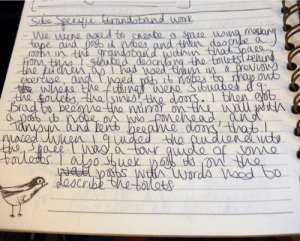Today during our session at the Grandstand, our lecturer asked us to create a space with masking tape, and then construct a tour of the space- modelling it on a room in the Grandstand building. We decided to focus on an unused bathroom, and above are the notes I made after the session describing what I had done. It reads:
“We were asked to create a space using masking tape and post it notes, and then describe a room in the Grandstand within that space. From this I started describing the toilets behind the kitchen as I had used them in a previous exercise, and I used post it notes to map out where the fittings were situated e.g. the toilets, the sinks, the doors. I then got Brad to become the mirror on the wall with a post it note on his forehead, and Tamsyn and Kent became doors that I moved when I guided the audience into the space. I was a tour guide of some toilets. I also stuck post its on the posts with words used to describe the space.”
This exercise was really interesting. It made me think about the recreation of space through different mediums as a performance, and how insignificant toilet spaces usually are; yet I was part of a tour of one, and its different elements were exposed in great detail when usually this kind of site is ignored.
What initially was just a part of the main room in the Grandstand was suddenly transformed with detail into an exact replica of the bathroom with masking tape. If someone had told me I would be doing that as a form of performance last year, I would have laughed, yet now this kind of creation of space really inspires me, and relates strongly to the Theatre/ Archaeology text: “…spaces are qualified by actions just as actions are qualified by spaces: architecture and events constantly transgress each other’s rules.” (Pearson and Shanks, 2001, p. 23). Constructing a masking tape bathroom in a space gives a purpose to that space, yet it has its own meaning before recreating a bathroom in it- the Grandstand’s many different rooms and spaces all have their own actions which are changed and explored through site specific performance.
Works Cited
Pearson, M. and Shanks, M. (2001) Theatre/ Archaology. Routledge.

